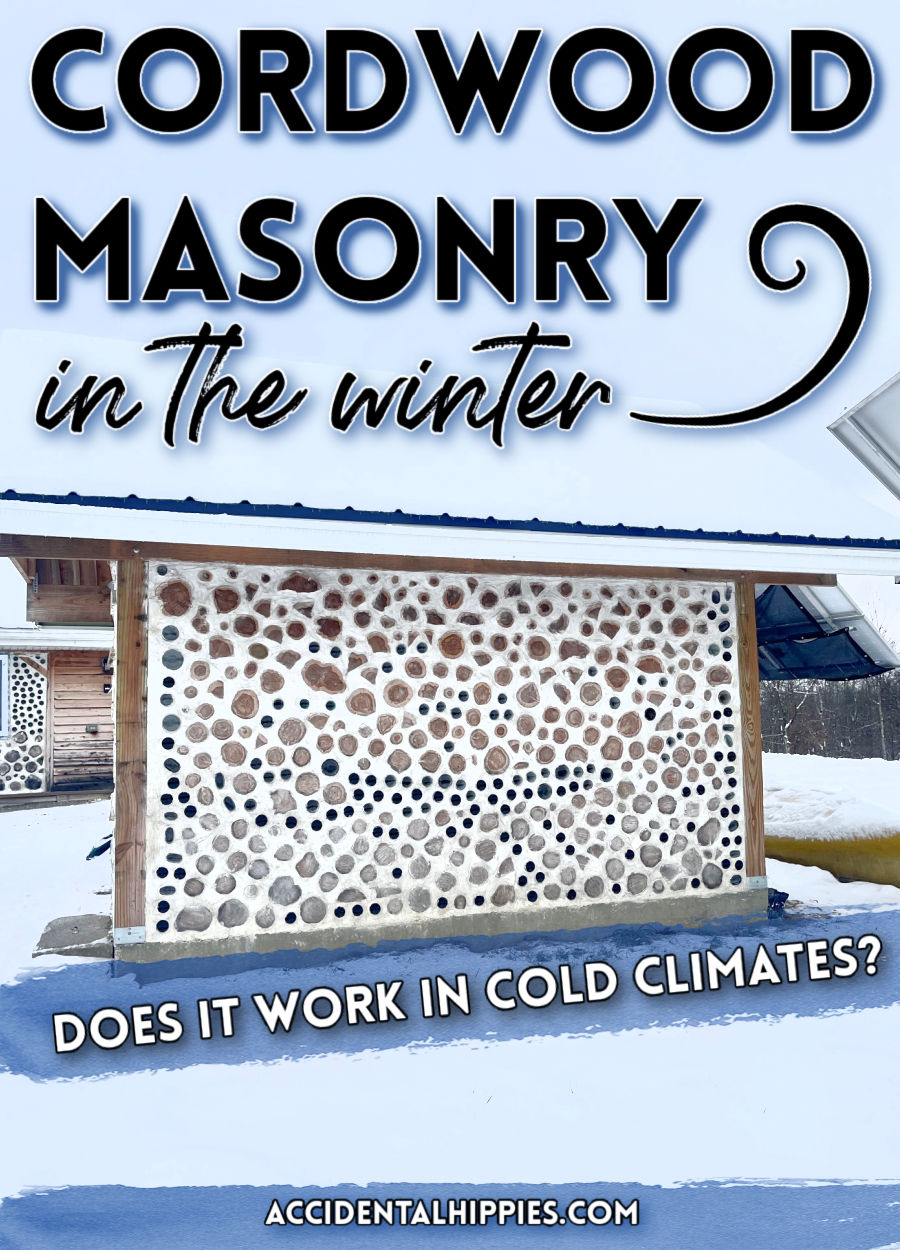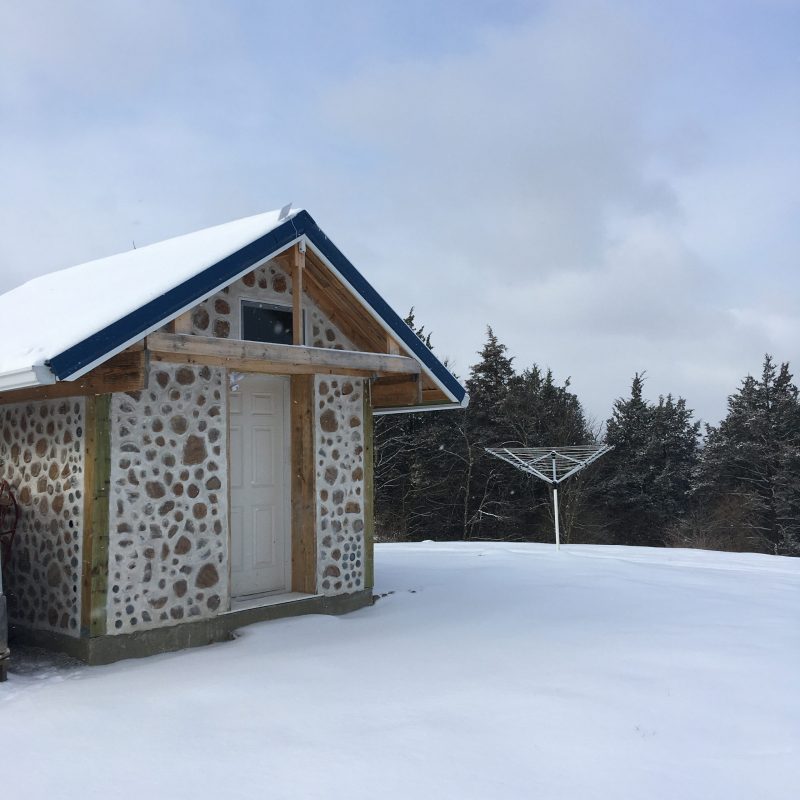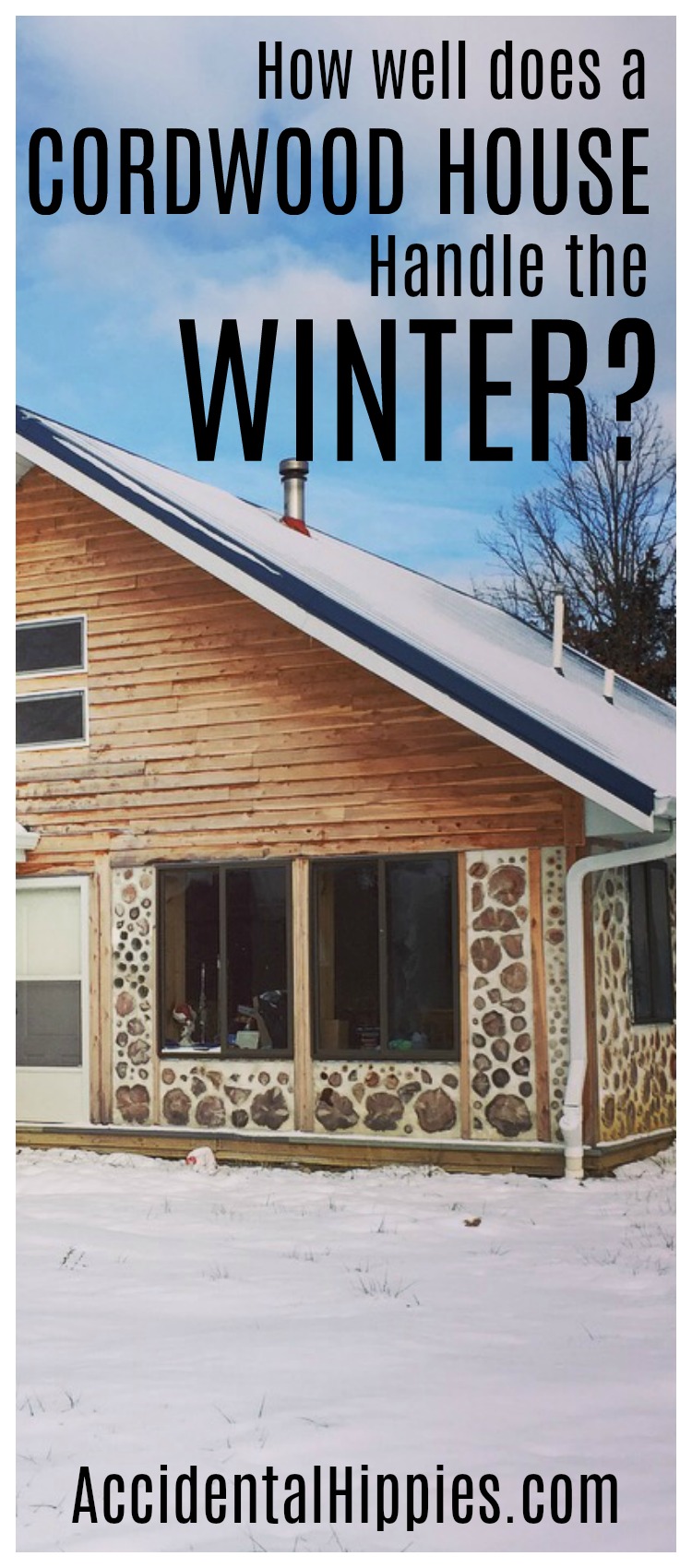Disclosure: I sometimes earn products or commissions from affiliate links or partnerships on my blog. I only recommend products and services I trust to serve you. Learn more.
Can cordwood houses withstand the bitter winter cold?
This is a question many folks ask about cordwood masonry. After all, it may seem counterintuitive that this kind of natural building method would perform well in places that experience bitter cold like the Northern U.S. and Canada. But it does!
In this post, I’ll take you through some of the most common questions we get about cordwood masonry in cold climates. I’ll also show you what our experience has been living in a cordwood home through some bitterly cold Kentucky winters.

Cordwood Houses In The Winter
First, if you’ve never seen our homestead project before, here are some quick facts about it:

- The house is 30’x34′ with a stud framed mudroom on the front measuring 8’x12′.
- Our cordwood walls are 16 inches thick and are made from eastern red cedar and a lime putty mortar.
- The cordwood walls are R-16 with 8 inches of softwood sawdust mixed with lime in the center cavity of the wall.
- The roof and stud wall insulation is open-cell spray foam with a rating up to R-40 at its thinnest points in the roof, and R-20 in the walls.
- There is approximately 855 square feet of living space on the first floor with a loft over the second half of the house measuring about 300 square feet.
- Our primary heat source is a soapstone wood stove made by HearthStone, with the secondary being the radiant heat in our slab foundation.
- We took advantage of some passive solar principles in our home design: oriented the home to solar south, lots of windows on the south face, fewer on the east and west, small windows on the north.
“Can you build a cordwood house in areas that get cold weather?”
This is probably the number one question I get from people, and the answer is a resounding YES. There are numerous cordwood homes throughout Canada and the northern United States. Double-wall construction is a particularly popular method among northern cordwood builders.
Cordwood homes, when built properly, stand up to the cold, ice, and snow in ways that traditional construction simply can’t. I’ll address why throughout this post as I go into more detail about our particular house.
You can learn more about proper cordwood construction practices here.
And for more information about cordwood homes in cold and snowy climates, read more here and here.
How OUR Cordwood Home Has Performed in the Winter
Every cordwood house and every location is different. Here’s some context to help you out.
Quick Stats:
- Gardening Zone 6B
- Average yearly snowfall: 12 inches
- Average high temperature: 43 F
- Average low temperature: 26 F
2018 Original Post Date Stats:
- Lowest temperature: -6 F (happens most winters, though people here will definitely complain like it’s a big deal)
- Highest temperature: 76 F (confusing and alarming when winter isn’t actually over yet)
- Snowfall: lower than normal, we only had 2 inches on the ground at any given time
2021 Update Stats:
- Lowest temperature: 4 F
- Highest temperature: 44 F
- Snowfall: 26 inches from November through February
Use these quick stats to give you context for how we answer these questions. Kentucky is certainly warmer than Canada, but we still experience sub-zero temps now and again.

1. How does cordwood handle the cold?
Until now, we’ve both only ever lived in older stud-framed homes with forced-air heating and cooling. Given this, we had no idea what to expect with an insulated cordwood house versus a standard home.
The thermal mass of the walls holds heat for HOURS. This includes heat from the sun and outside air as well as heat from the radiant system and wood stove.
That being said, if the walls are cold it takes a LONG time to warm up. We went out of town for several days when the temperatures didn’t get out of the low teens, and had lowered the set temperature on the radiant, which was a mistake. Getting the house warmed back up to a livable temperature took several hours but once it reached that temperature it held steady.
2022 UPDATE: THE SOLAR SHED
This is the second winter for our cordwood solar shed, and we’ve been pretty impressed with how it has handled the cold so far. We implemented similar passive solar principles into its design, including putting a big window on the south face and painting the floor black. (The picture below is before we painted the floor, which honestly was a bit of an afterthought.)

This small building has NO auxiliary heating or cooling systems. Instead, we monitor the temperature via this Bluetooth thermometer station in the house. When it starts getting closer to freezing (i.e. around 34-37 degrees Fahrenheit) we’ll run a propane heater for a few hours to boost the temperature back up to keep the batteries and system components working optimally.
This typically gets the building to around 70 degrees inside initially. The temperature will usually drop to around 55 degrees in the 8-12 hours after we turn the heater off, and then it tends to either drop slowly over a period of weeks or stay around the same, depending on the weather.
At the time of this writing in the 2021-22 winter season, we have run the heater a grand total of THREE times. Temperatures outside have been hanging out well below freezing for several weeks, and we will probably run the heater again a few more times before spring arrives, but the building has stayed fairly consistent (around 40-50 degrees) no matter what the temperature outside is doing. Thermal mass and insulation at work!
2. What about SNOW? How do you keep it from drifting against the walls?
Great question! One cordwood best practice is to have much wider roof overhangs than a traditionally built home might.
Our home has a 24-inch overhang around the entire home. This is the minimum generally accepted to protect cordwood walls. We don’t live in an area where we ever have lots of snow on the ground, so a deep overhang wasn’t a concern for us.
If you’re considering cordwood and live in an area that gets truly deep snows, consider designs with overhangs of at least 3-4 feet or a wrap-around porch. This is a great way to protect your cordwood from all kinds of inclement weather.
3. How well does passive solar design really work with cordwood?
Imagine a sunny but bitterly cold day. The sun is blazing but the outside temperature barely gets above zero.
Because we have a lot of south-facing windows we can take advantage of the sun on frigid days like this. The heat of the sun warms the walls and the slab, meaning that on those kinds of days the house stayed comfortable without maintaining a fire in the stove AND without the radiant heat ever kicking on.
Even on very cloudy days, the amount of light reaching the windows is enough to avoid having the lights on. This means we’re saving power and harnessing energy no matter what.
That said, I do wish we could have developed a design to face the long side of the house towards the south. The bedrooms on the north wall do have a tendency to feel a little bit colder, but the difference is pretty slight. On a positive note, this actually makes sleeping much more comfortable, so I don’t think it’s necessarily a bad thing.
4. Do you have enough power to get through winter days in a cordwood house?
The nature of cordwood actually plays quite nicely with an off-grid power system.
Our home is entirely off the grid, which means we have a system of solar panels and batteries to power our home.
The system we had (at the time of this writing) was relatively small at roughly 1.14 kW worth of solar panels. Since our radiant heat system uses electricity to power the pumps and to keep the propane water heater on, it does eat up about 250-500 watts of power at a time while it’s running.
Fortunately, the nature of the thermal mass and insulation in our home means our radiant heat system doesn’t have to kick on nearly as often as it might in a typical stud-framed home.
On those days with high temperatures in the single digits, our radiant kicked on every few hours at the most. Every other “normal” home I have ever lived in keeps the heat running almost constantly all day and night when the temperature is that low.
You can read more about our experiences with off-grid solar power in the winter here.
5. Does the house creak or moan in high winds?
No. Not even a little.
This was a weird one to us because we’ve never been in a house that doesn’t creak or groan at least a little bit in a high wind.
Honestly, we’re not sure if it’s because the walls are so stout, because of all the insulation in the roof, or because we have two sets of hurricane clips on every truss (long silly story).
Either way, our house doesn’t flinch at the few winter storms we’ve had with sustained high winds.
6. Is cordwood drafty?
No, thankfully. The image below shows a cross-section of a cordwood wall going up. This will start to give you an idea of WHY cordwood masonry built with best practices shouldn’t develop drafts.

Drafts do not form easily because of the nature of the wall system. In order for you to feel a breeze, you’d first need a gap between the log and mortar on the outside of the wall, followed by a void in the insulation, followed by another gap between the log and mortar on the inside wall.
I had this concern once too. But as I actually constructed a cordwood wall, it became obvious why it shouldn’t develop drafts. Even if you get some log shrinkage on the outside, your insulation should be packed enough inside the walls to “catch” any air that comes in. And if the insulation is doing its job, the air would still have to come through an equally problematic gap on the inside wall. We were very deliberate through the building process and, as a result, haven’t experienced any drafts in the cordwood.
You can sit right next to any part of the wall and even in a high wind you won’t feel a draft. The issue many people face with this is if the walls are completely solid and uninsulated. When the logs shrink in an uninsulated system, there’s nothing in the middle to act as a buffer to the air.
Our home is a single-wall system, but double-wall systems offer an extra layer of redundancy, virtually ensuring no chances of a draft.
Related: Cordwood for Beginners
7. Do you have problems with log shrinkage?
Not particularly. There has been some shrinkage, which is to be expected with wood, but nothing major. Know why?
We dried the vast majority of our logs for a little over a year to approximately a 12-16% moisture level. However, we did end up cutting some trees down during the summer right before we started our walls. They managed to dry to about 16-20% in the hot summer sun, but they weren’t nearly as seasoned as the others.
To make the most of this situation, we put the most seasoned logs in the walls that received the most direct weather hits on the west and north. We put the newer logs on the east wall, which receives almost no direct beating from the weather in our area.
As a result, the most dramatic shrinkage I’ve seen is about 1/8th of an inch. More typical shrinkage is barely visible to maybe 1/16th of an inch.
If you have to build with “wet” logs, be prepared to use something like Log Jam or Permachink to mitigate the shrinkage you get. But if you have the option and the time, cut and prepare all of your logs at least a year before you build.
You can learn more about how we prepped our cedar logs here.
8. How is your interior air quality? Is it as “sealed” as a lot of newer homes?
The indoor air quality in our cordwood home is quite pleasant compared to traditional construction.
Here we have the double effects of cordwood construction and the total lack of forced air heating and cooling in our home.
Cordwood by its very nature is sealed yet breathable. Because the logs have their end grain facing out on both sides of the wall they allow an exchange of air through the grain. This has kept our inside air from ever feeling or smelling stagnant.
Related: End grain out? Learn how to prevent rot in a cordwood wall.
And since we aren’t blowing germs and dust through any vent systems, we’ve managed to reduce our winter sniffles quite dramatically.
Additionally, our indoor humidity tends to hang out between 35-45%, so it’s low but not “nosebleed low”. Plus it lets our laundry air dry super fast!

9. Do you have any issues with bugs inside your cordwood home this winter?
No! No issues at all except for stinkbugs and the occasional ladybug. This has been a pretty interesting thing to see since I’ve been so accustomed to seeing spiders and house centipedes all winter long everywhere else I’ve lived.
I haven’t seen a single spider or centipede all winter long. During the summer I would watch carpenter bees fly up to our house and hover as if they’re checking it out. Every single time they’d just fly away without even making contact with our house.
I chalk this up to the large amount of cedar covering everything. Our cordwood is Eastern Red Cedar and so is the siding on our roof gables, so it’s fairly pest resistant.
The only bugs that don’t seem to care are the stink bugs, which while harmless are completely annoying. We had a stink bug crawl into a smoke detector at 3:00 in the morning and give us all a scare. So hey, if anyone has any great stink bug solutions that actually work please share!!
So there you have it! Everything we’ve learned about our cordwood house over the last few winters.
I hope we hit the main questions that people ask, but I’m sure you might have more. If I missed something, feel free send me a message on Facebook or Instagram.
2022: This is the sixth winter the cordwood walls have existed, and the fifth winter living in it. I’m sure that as the years roll by things will change. We’ll do our best to keep you updated, especially all of you aspiring cordwood builders out there.
2023-2024: I reread this post and the house seems to be pretty stable. The walls are in basically the exact same shape as previous years with no additional shrinkage. The portions where I sealed some gaps with Log Jam years ago haven’t weathered a bit and still blend right in with the original mortar. We had some incredible subzero cold snaps in these years and, while we had to keep the fire going in the woodstove more often on those days, the house didn’t struggle to maintain a warm, even temperature. Overall, we’re very pleased with how our cordwood house performs in the winter!
Want to know more about building with cordwood? Grab our free eBook showing exactly what went into building our home:
Interested in building with cordwood for yourself? Check out our Building With Cordwood Masonry Online Course!

Check out our homestead progress and find out more about our cordwood homestead project here. You should also join us on Facebook, Twitter, and Instagram. I’m always pinning lots of great ideas on Pinterest too! Thanks for reading!

Do you run the electric and plumbing in the walls or exposed inside the house…can you stucco the inside for smooth walls
We ran our electrical surface-mounted in conduit. You can see it in this post here: Running Electrical Wiring In or On Cordwood Walls . All of our plumbing is inside the stud walls on the interior of the house, and enters the house through the slab in our mudroom. We chose not to run anything in the cordwood walls in the event that there was a burst pipe or a wire that needed to be redone for any reason. Less opportunity to damage the cordwood and easier opportunities for repair should the need arise. As for stucco, I have heard of people doing this but can’t seem to find an appropriate link to anything that is still posted to read. We have not done it personally so I can’t make any recommendations for how to do it or precautions to take. One possible solution is to build cordwood using a double-wall technique but then instead of doing cordwood on the interior finishing out with smooth walls instead. It’d be like a cordwood siding, in a way. Hope that helps!